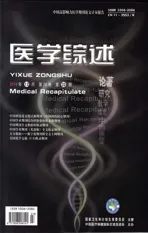EGFR/EGFRvⅢ促头颈肿瘤上皮-间质转移的研究
2014-03-06宋新貌综述王胜资审校
宋新貌(综述),王胜资(审校)
(复旦大学附属眼耳鼻喉科医院放疗科,上海 200031)
头颈肿瘤已成为第6位高发的肿瘤,全球每年约有65万例新增病例,约35万患者死亡[1]。目前针对头颈肿瘤的治疗方式主要有手术、放疗、化疗,但是头颈肿瘤的预后仍然不容乐观,复发和转移是治疗失败的主要原因。较多研究证实头颈肿瘤中表皮生长因子受体(epithelial growth factor receptor,EGFR)的表达率高达90%以上,其突变体表皮生长因子受体三型突变(EGFR varient Ⅲ,EGFRvⅢ)在头颈肿瘤也有表达。EGFR/EGFRvⅢ通过多种信号途径在促进肿瘤细胞增殖、诱导血管新生、提高细胞侵袭和转移能力、拮抗肿瘤对化疗和放疗的敏感方面起着重要作用,因而其过表达影响肿瘤的预后和治疗。深入研究发现,这些恶性生物性行为的呈现与肿瘤细胞发生的上皮-间质化转移(epithelial-mesenchymal transition,EMT)变化有密切的关系[2]。对EGFR和EGFRvⅢ的结构及其配体、两者参与的信号通路、在肿瘤中的表达及对预后的影响、促进EMT变化的机制和对治疗的影响作如下综述。
1 EGFR/EGFRvⅢ的结构及其配体
EGFR(ErbB1和Her1)属于ErbB家族一个成员,有富含半胱氨酸的细胞外结构与相应的配体相结合,一个跨膜结构能将受体锚定在胞膜上,膜内区具有典型的ATP结合位点及酪氨酸激酶结构。EGFR常见的配体有表皮生长因子、肿瘤生长因子α、双调蛋白、肝素结合的表皮生长因子样生长因子、B细胞生长因子、表皮调节素。
EGFR及其下游信号系统:Ras/Raf/丝裂原活化蛋白激酶的激酶/细胞外信号调节激酶/丝裂原活化蛋白激酶通路;磷脂酰肌醇3-激酶/蛋白激酶B/哺乳动物雷帕霉素靶蛋白通路;Janus激酶/信号转导子和转录激活子3通路;磷酸激酶C-γ1/蛋白激酶C通路;蛋白激酶C-δ通路触发效应细胞在增殖、迁移、黏附等正常生理功能中发挥重要作用。EGFR在脑、肺、乳腺、卵巢、前列腺、胰腺、头颈等多种肿瘤中过表达,参与肿瘤细胞的增殖、生存、转移及新生血管的形成,改变转录因子的活性,调节细胞凋亡,调整细胞周期,促进转移的恶性生物学行为[3]。
在头颈肿瘤中常见EGFR基因外显子2~7区的缺失突变,这种突变引起801个碱基对的缺失和胞膜外区域结构变短,而产生一个150×103的EGFRvⅢ蛋白,它不需要配体的激活就能够自发磷酸化触发胞内效应[4]。尽管EGFRvⅢ缺乏细胞外配体结合区域,但能刺激下游的信号途径有磷脂酰肌醇3-激酶/蛋白激酶B-1而不能激活Ras/Raf/丝裂原活化蛋白激酶[5]。其实EGFRvⅢ最先在人胶质母细胞瘤中被发现,后证实在头颈、肺、卵巢等多种肿瘤中表达,但在正常组织中不表达[6]。EGFRvⅢ在肿瘤的发生、进展中的主要作用包括促进细胞增殖、诱导血管新生、提高肿瘤侵袭和转移能力、拮抗肿瘤细胞对化疗和放疗的敏感性[7]。另外发现表达EGFRvⅢ的肿瘤细胞甚至具有肿瘤干细胞的特征和自我更新的能力[8]。
2 EGFR/EGFRvⅢ在头颈肿瘤中的表达及预后
EGFR在哺乳动物组织中,尤其是在其上皮、间质、神经源性器官中广泛表达,EGFR在上皮性肿瘤(如乳腺癌、前列腺癌、肺癌、神经胶质瘤)中均广泛表达[9]。在头颈肿瘤中表达较为常见:87.5%(35/40)的口腔鳞癌[10],89%(48/54)的鼻咽癌[11],93.3%(42/45)的喉癌[12]组织均有EGFR的过表达,其中68%(44/65)头颈肿瘤的患者呈高表达(+2,+3)[13]。不仅蛋白水平有表达异常,通过原位杂交技术发现80%(82/102)的患者EGFR mRNA上调,17.2%(11/64)的患者发生EGFR基因扩增[14]。EGFR的高表达与肿瘤的体积、T分期有密切相关性,且与肿瘤进展有关[15];高表达的EGFR使肿瘤细胞具有更强的侵袭性表型,而且下调对放射和化疗的敏感性,显著缩短疾病进展时间[16]。
EGFRvⅢ不仅存在于神经胶质瘤,后来证实在其他恶性肿瘤,如非小细胞性肺癌、乳腺癌、卵巢癌中也有表达、尤其在头颈部肿瘤中EGFRvⅢ表达较常见。Szabó等[17]回顾性分析71例头颈肿瘤患者病理资料,其中15例(21%)有EGFRvⅢ的缺失突变。Sok等[18]认为EGFRvⅢ在42%(14/33)的头颈肿瘤中表达。EGFRvⅢ的表达诱发肿瘤细胞提高迁移能力和抗凋亡能力也表现对放疗、化疗药物和靶向治疗的拮抗性[19-20]。
3 EGFR/EGFRvⅢ促进EMT或转移的机制
EMT使上皮细胞失去了细胞极性等上皮表型,获得了较高的迁移与侵袭等间质细胞表型,其特征性变化:上皮细胞失去正常立方形态而变成纺锤性结构;细胞连接蛋白上皮钙黏素减少,而间质细胞的标志物波形蛋白增加[21]。EMT涉及细胞间的黏附破坏、细胞与基质间黏附增强、细胞极性变化、细胞骨架重组、细胞外基质成分分子合成与聚集变化、细胞外蛋白酶的上调与激活等细胞形态和功能的变化。
目前,大量证据已经证实EGFR和EGFRvⅢ能够诱导肿瘤细胞发生EMT样变化,那么EGFR和EGFRvⅢ是如何诱导肿瘤细胞EMT变化的呢?主要表现在以下几个方面。
3.1调节细胞外基质成分 细胞外基质成分是由大分子构成的错综复杂的网络。为细胞的生成及活动提供适宜的场所,并通过信号转导系统影响细胞的形状、代谢、功能、迁移、增殖和分化。细胞外基质成分与生长因子结合能影响细胞的表型和生物学行为,EGFR和EGFRvⅢ可调节纤溶酶原激活物抑制1、尿激酶纤维蛋白溶酶原激活剂和尿激酶型纤溶酶原激活物受体发挥细胞的纤维蛋白溶解作用[22]。EGFR可以通过细胞外信号调节激酶1/2和磷脂酰肌醇3-激酶途径增加基质金属蛋白酶9的表达来降解细胞外基质成分和上皮钙黏素使细胞发生EMT[23];表皮生长因子结合EGFR后能够刺激透明质酸的生产,透明质酸的增加可以导致透明质酸依赖的细胞外基质增加,促进上皮细胞的迁移能力及发生间质化形态学变化,失去上皮标志上皮钙黏素而获得间质细胞的特性波形蛋白,另外透明质酸与其表面受体CD44结合使细胞发生EMT变化[24]。
3.2重塑细胞骨架结构 EGFR T790M突变的非小细胞肺癌的细胞transmembrane 4 L six family member 5(TM4SF5)表达增加,TM4SF可以和整合素α2、α5协同作用改变细胞骨架结构,诱导细胞发生EMT变化[25];转化生长因子β1和EGFR信号协同调节TM4SF5的表达,而TM4SF5能够增加α平滑肌激动蛋白的表达使细胞间的黏附下降,因此细胞获得EMT样表型[26];在宫颈癌细胞中EGFR过表达与上皮钙黏素下调,神经钙黏素的上调呈平行关系,进一步分析发现,整合素α5β1和细胞外基质纤连蛋白调整表皮生长因子诱导的宫颈癌细胞EMT过程[27]; Staurosporine(ST)是一种非典型的蛋白激酶C抑制剂,能迅速分解F肌动蛋白束,导致细胞间黏附的不稳定,扩大EGFR信号的EMT作用[28]。在头颈肿瘤细胞中EGFR能够激活Rac1交换因子Vav2,激活的Vav2诱导肌动蛋白构象变化而调整细胞骨架的重组,这一系列变化使肿瘤细胞获得黏附性、极性、侵袭性[29]。EGFR与CD44相互作用活化磷脂酶ε-Ca2+和Ras/Raf/细胞外信号调节激酶上调后激活钙-钙调节蛋白依赖性激酶Ⅱ使细丝蛋白磷酸化而增加头颈肿瘤细胞的迁移力[30]。
3.3直接上皮钙黏素的内吞和降解 高表达EGFR的肿瘤细胞以EGF刺激后,细胞通过细胞质膜微囊依赖的机制内吞上皮钙黏素;EGF刺激后导致β联蛋白与上皮钙黏素解离,一方面直接降解上皮钙黏素,另一方面β联蛋白进入核内激活T细胞因子/淋巴增强因子1[31];在头颈鳞状细胞癌10A细胞系EGFR激活后通过基质金属蛋白酶9作用使上皮钙黏素降解为可溶性的钙黏素促进的迁移和侵袭[23]。Rho家族三磷酸鸟苷酶Cdc42,激活EGFR信号通路接到Src的激活,引起上皮钙黏素蛋白泛素化和溶酶体的降解,使细胞发生间质化表型[32]。在头颈肿瘤细胞中发现上皮钙黏素的降解反过来短暂上调EGFR的表达,再次触发下游通路的激活[33]。
3.4抑制上皮钙黏素转录因子的表达 调节EMT的重要转录因子包括:snail、slug、E盒结合锌指蛋白(zinc finger E-box-binding protein,ZEB)1/2、Twist。EGFR能促进Snail的激活,EGFR抑制剂能够抑制snail mRNA的表达[34];EGFR信号通路使得糖原合成酶激酶3β失活,糖原合成酶激酶3β能磷酸化Snail并促进核内移和蛋白分解,因此上调Snail,使细胞核内的Snail增多[27];以小干扰RNA诱导序列特异性的沉寂EGFR后能终止EGF诱导上皮钙黏素向神经钙黏蛋白的转换,同时抑制Snail,Slug和ZEB1表达[35],同样以小干扰RNA诱导序列特异性的沉寂EGFR后人胰腺癌细胞的迁移和侵袭力受到抑制,上皮标志物上皮钙黏素增加,间质标志物波形蛋白、神经钙黏蛋白、纤连蛋白减少,Sail和slug的表达下调[36];表皮生长因子/EGFR信号通路通过信号转导与转录激活因子3调节Twist基因的表达诱导肿瘤细胞发生EMT变化,Twist的表达可以被EGFR和Janus激酶/信号转导子和转录激活子3通路抑制剂所阻断[37];EGFRvⅢ阳性细胞通过wnt/β联蛋白途径激活β联蛋白,激活的β联蛋白变得稳定,转移到细胞核内激活转录因子T细胞因子/淋巴增强因子1促进细胞发生EMT变化[8];激活的EGFR进一步引起核因子κB 的激活预示肿瘤发生侵袭,因为核因子κB可与波形蛋白基因启动子调节序列结合,促进Twist表达,诱导EMT[38]。发现EGFR和p53突变体协同作用使富含EMT变化的人类食管癌细胞的ZEB1/ZEB2表达增强,抑制p15INK4B和p16INK4A,从而克服EGFR介导的衰老[39]。
4 展 望
目前针对EGFR的分子靶向治疗主要包括单克隆抗体(如西妥昔单抗、尼妥珠单抗)和酪氨酸激酶受体抑制剂(如吉非替尼、厄洛替尼),已经广泛应用于临床并取得一定疗效。也有专门针对特异性结合EGFRvⅢ的单克隆抗体的研发,这种抗体具有较好的抑制肿瘤生长的作用且不易被正常组织吸收。但是,很多肿瘤患者经靶向治疗后并没有期待的效果,甚至表现对靶向治疗的拮抗。EGFR/EGFRvⅢ引起的EMT变化在加速头颈肿瘤的侵袭和转移中发挥重要作用。随着对EGFR/EGFRvⅢ分子病理和基因学水平的深入研究,以及其诱发EMT的机制的明确,能够更加清楚地认识这一变化过程在肿瘤的发生、发展中的作用。针对EGFR/EGFRvⅢ的抗肿瘤药物研究和开发具有广阔的前景,尤其是针对EGFRvⅢ的靶向治疗药物,因为其仅在肿瘤中表达,那么理论上对正常组织的不良反应更少。
[1] Ferlay J,Shin HR,Bray F,etal.Estimates of worldwide burden of cancer in 2008:GLOBOCAN 2008[J].Int J Cancer,2010,127(12):2893-2917.
[2] Misra A,Pandey C,Sze SK,etal.Hypoxia activated EGFR signaling induces epithelial to mesenchymal transition (EMT)[J].PLoS One,2012,7(11):e49766.
[3] Vecchione L,Jacobs B,Normanno N,etal.EGFR-targeted therapy[J].Exp Cell Res,2011,317(19):2765-2771.
[4] Gan HK,Burgess AW,Clayton AH,etal.Targeting of a conformationally exposed, tumor-specific epitope of EGFR as a strategy for cancer therapy[J].Cancer Res,2012,72(12):2924-2930.
[5] Mukherjee B,Mcellin B,Camacho CV,etal.EGFRvIII and DNA double-strand break repair: a molecular mechanism for radioresistance in glioblastoma[J].Cancer Res,2009,69(10):4252-4259.
[6] Nedergaard MK,Hedegaard CJ,Poulsen HS.Targeting the epidermal growth factor receptor in solid tumor malignancies[J].BioDrugs,2012,26(2):83-99.
[7] Wnorowski AM,De Souza A,Chachoua A,etal.The management of EGFR inhibitor adverse events: a case series and treatment paradigm[J].Int J Dermatol,2012,51(2):223-232.
[8] Del Vecchio CA,Jensen KC,Nitta RT,etal.Epidermal growth factor receptor variant III contributes to cancer stem cell phenotypes in invasive breast carcinoma[J].Cancer Res,2012,72(10):2657-2671.
[9] Ri N,Jm G,Me H.EGFR and cancer prognosis[J].Eur J Cancer,2001,37(Suppl 4):S9-S15.
[10] Sarkis SA,Abdullah BH,Majeed BA,etal.Immunohistochemical expression of epidermal growth factor receptor (EGFR) in oral squamous cell carcinoma in relation to proliferation,apoptosis,angiogenesis and lymphangiogenesis[J].Head Neck Oncol,2010,2(13):1-8.
[11] Chua DT,Nicholls JM,Sham JS,etal.Prognostic value of epidermal growth factor recrptor expression in patients with advanced stage nasopharyngeal carcinoma treated with induciton chemotherapy and radiotherapy[J].Int J Radiation Oncology Biol Phys,2004,59(1):11-20.
[12] Starska K,Glowacka E,Lewy-Trenda I,etal.EGFR immunoexpression and peripheral blood cytokine secretion as potential biomarkers of tumor behavior in laryngeal squamous cell carcinoma[J].Med Sci Monit,2009,15(10):CR518-CR527.
[13] Sheikh Ali MA,Gunduz M,Nagatsuka H,etal.Expression and mutation analysis of epidermal growth factor receptor in head and neck squamous cell carcinoma[J].Cancer Sci,2008,99(8):1589-1594.
[14] Pectasides E,Rampias T,Kountourakis P,etal.Comparative prognostic value of epidermal growth factor quantitative protein expression compared with FISH for head and neck squamous cell carcinoma[J].Clin Cancer Res,2011,17(9):2947-2954.
[15] Leong JL,Loh KS,Putti TC,etal.Epidermal growth factor receptor in undifferentiated carcinoma of the nasopharynx[J].Laryngoscope,2004,114(1):153-157.
[16] Tinhofer I,Klinghammer K,Weichert W,etal.Expression of amphiregulin and EGFRvIII affect outcome of patients with squamous cell carcinoma of the head and neck receiving cetuximab-docetaxel treatmen[J].Clin Cancer Res,2011,17(15):5197-5204.
[17] Szabó B,Nelhubel GA,Kárpáti A,etal.Clinical signi cance of genetic alterations and expression of epidermal growth factor receptor (EGFR) in head and neck squamous cell carcinomas[J].Oral Oncology,2011,47(46):487-496.
[18] Sok JC,Coppelli F,Thomas S,etal.Mutant epidermal growth factor receptor (EGFRvIII) contributes to head and neck cancer growth and resistance to EGFR targeting[J].Clin Cancer Res,2006,12(17):5064-5073.
[19] Wheeler SE,Suzuki S,Thomas SM,etal.Epidermal growth factor receptor variant Ⅲ mediates head and neck cancer cell invasion via STAT3 activation[J].Oncogene,2010,29(37):5135-5145.
[20] Wang H,Jiang H,Zhou M,etal. Epidermal growth factor receptor variant Ⅲ enhances tumorigenicity and resistance to 5-fluorouracil in human hepatocellar carcinoma[J].Cancer Lett,2009,279(1):30-38.
[21] Klymkowsky MW,Savagner P.Epithelial-mesenchymal transition:a cancer researcher′s conceptual friend and foe[J].Am J Pathol,2009,174(5):1588-1593.
[22] Garnier D,Magnus N,D′asti E,etal.PL-05 genetic pathways linking hemostasis and cancer[J].Thromb Res,2012,129(Suppl 1):s22-s29.
[23] Zuo JH,Zhu W,Li MY,etal.Activation of EGFR promotes squamous carcinoma SCC10A cell migration and invasion via inducing EMT-like phenotype change and MMP-9-mediated degradation of E-cadherin[J].J Cell Biochem,2011,112(9):2508-2517.
[24] Chow G,Tauler J,Mulshine JL.Cytokines and growth factors stimulate hyaluronan production:role of hyaluronan in epithelial to mesenchymal-like transition in non-small cell lung cancer[J].J Biomed Biotechnol,2010,2010:485468
[25] Lee MS,Kim HP,Kim TY,etal.Gefitinib resistance of cancer cells correlated with TM4SF5-mediated epithelial-mesenchymal transition[J].Biochim Biophys Acta,2012,1823(2):514-523.
[26] Kang M,Choi S,Jeong SJ,etal.Cross-talk between TGFbeta1 and EGFR signalling pathways induces TM4SF5 expression and epithelial-mesenchymal transition[J].Biochem J,2012,443(3):691-700.
[27] Lee MY,Chou CY,Tang MJ,etal.Epithelial-mesenchymal transition in cervical cancer: correlation with tumor progression, epidermal growth factor receptor overexpression, and snail up-regulation[J].Clin Cancer Res,2008,14(15):4743-4750.
[28] Hugo HJ,Wafai R,Blick T,etal.Staurosporine augments EGF-mediated EMT in PMC42-LA cells through actin depolymerisation, focal contact size reduction and Snail1 induction-a model for cross-modulation[J].BMC Cancer,2009,9:235.
[29] Patel V,Rosenfeldt HM,Lyons R,etal.Persistent activation of Rac1 in squamous carcinomas of the head and neck:evidence for an EGFR/Vav2 signaling axis involved in cell invasion[J].Carcinogenesis,2007,28(6):1145-1152.
[30] Bourguignon LY,Gilad E,Brightman A,etal.Hyaluronan-CD44interaction with leukemia-associated RhoGEF and epidermal growth factor receptor promotes Rho/Ras co-activation, phospholipase C epsilon-Ca2+signaling,and cytoskeleton modification in head and neck squamous cell carcinoma cells[J].J Biol Chem,2006,281(20):14026-14040.
[31] Lu Z,Ghosh S,Wang Z,etal.Downregulation of caveolin-1 function by EGF leads to the loss of E-cadherin, increased transcriptional activity of β-catenin, and enhanced tumor cell invasion[J].Cancer Cell,2003,(6):499-515.
[32] Shen Y,Hirsch DS,Sasiela CA,etal.Cdc42 regulates E-cadherin ubiquitination and degradation through an epidermal growth factor receptor to src-mediated pathway[J].J Biol Chem,2008,283(8):5127-5137.
[33] Wang D,Su L,Huang D,etal.Downregulation of E-cadherin enhances proliferation of head and neck cancer through transcriptional regulation of EGFR[J].Mol Cancer,2011,10:116.
[34] Forsyth CB,Tang Y,Shaikh M,etal.Alcohol stimulates activation of Snail, epidermal growth factor receptor signaling,and biomarkers of epithelial-mesenchymal transition in colon and breast cancer cells[J].Alcohol Clin Exp Res,2010,34(1):19-31.
[35] Cheng JC,Auersperg N,Leung PC.EGF-induced EMT and invasiveness in serous borderline ovarian tumor cells: a possible step in the transition to low-grade serous carcinoma cells?[J].PLoS One,2012,7(3):e34071.
[36] Chang ZG,Wei JM,Qin CF,etal.Suppression of the epidermal growth factor receptor inhibits epithelial-mesenchymal transition in human pancreatic cancer PANC-1 cells[J].Dig Dis Sci,2012,57(5):1181-1189.
[37] Lo HW,Hsu SC,Xia W,etal.Epidermal growth factor receptor cooperates with signal transducer and activator of transcription 3 to induce epithelial-mesenchymal transition in cancer cells via up-regulation of TWIST gene expression[J].Cancer Res,2007,67(19):9066-9076.
[38] Gavert N,Ben-Ze′e A.Epithelial-mesenchymal transition and the invasive potential of tumors[J].Trends Mol Med,2008,14(5):199-209.
[39] Ohashi S,Natsuizaka M,Wong GS,etal.Epidermal growth factor receptor and mutant p53 expand an esophageal cellular subpopulation capable of epithelial-to-mesenchymal transition through ZEB transcription factors[J].Cancer Res,2010,70(10):4174-4184.
